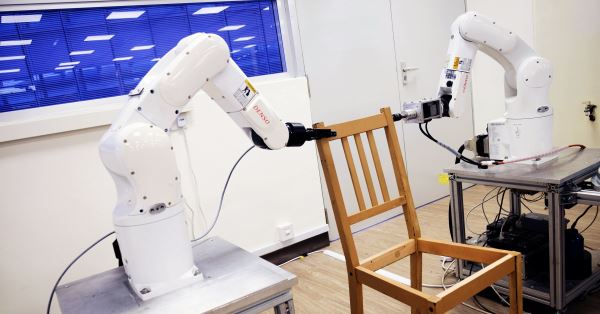Assembling flat-pack furniturecan be a real challenge for most of us.
It’s been known to cause major arguments and put a strain on the strongest relationships.
But now it seems, there’s an easier way.
A team of roboticists from Nanyang Technological University in Singapore has unveiled a semi-autonomous pair of robotic arms that can put together the frame of an IKEA chair.
Their ground breaking invention was highlighted in the latest edition of Science Robotics.
Made from off-the-shelf equipment, their two robots can look at chair parts scattered around, grasp and lift the right bit, carefully insert wooden pins in pre-drilled holes and slot the pieces together.
And while the robot's repertoire of furniture-building skills is limited – it can't yet screw in metal screws, for instance – the technology could soon be ready for jobs that require human-like dexterity, such as electronics and aircraft manufacturing.
Three years of work
The seemingly simple task of putting together a few pieces of wood involved around three years of work, said Quang-Cuong Pham, who is one of the robot's creators.
This is because even though the robotic arms are equipped with 3D cameras, the image resolution isn't quite good enough for the robotic fingers to pop the pin in on the first try all the time.
"The camera is good to around 2 or 3 millimetres, but that's not precise enough for the snug-fitting wooden pins.
"So that's why the pin lands on the surface of the wood block, then moves around to search for the hole."
Sensors on the robotic "wrists" detected if a pin successfully slid into the hole.
All up, the robotic arms took about 20 minutes to put a chair frame together, spending about 11 minutes planning their motions and nine minutes executing them.
This is how it works:
- The robot starts the assembly process by taking 3D photos of the parts laid out on the floor to generate a map of the estimated positions of the different parts.
Next, using algorithms developed by the team, the robot plans a two-handed motion that is fast and collision-free.
- The force sensors mounted on the wrists help to determine the amount of force required, allowing the robot to precisely and consistently detect holes by sliding the wooden plug on the surfaces of the work pieces, and perform tight insertions.
The next step, Dr Pham said, is to fully automate the furniture-building process by incorporating advanced artificial intelligence.
"It's not full autonomy (yet) in the sense that the set of instructions still has to be given by us," he said.
And a laboratory is different to the real world where a flat pack might be missing a piece, or a pin might not fit in a hole.
Despite advances in artificial intelligence and engineering, a fully autonomous furniture-building robot is still a long way off, say experts.
So, unfortunately those of us who aren’t adept to assembling flat-pack furniture will have to wait for at least for a few years more for a robotic solution.


